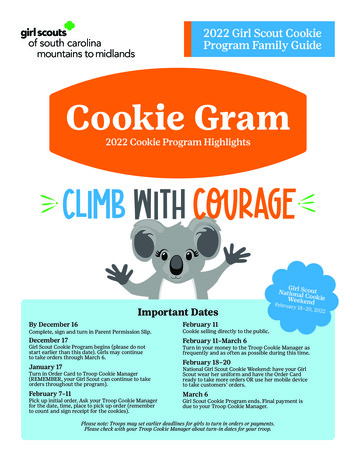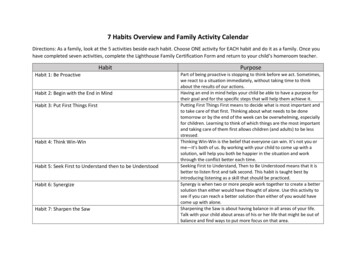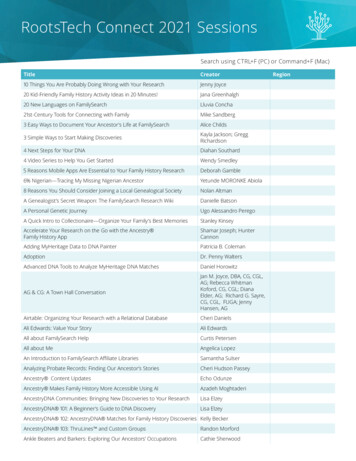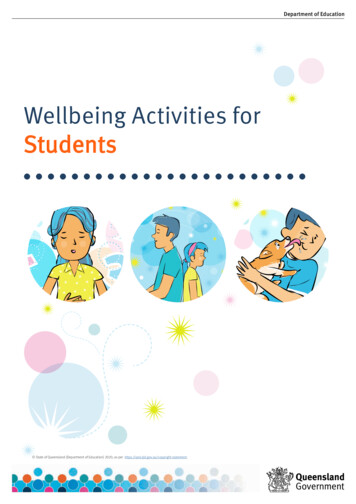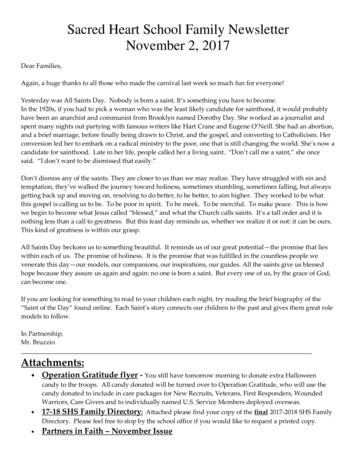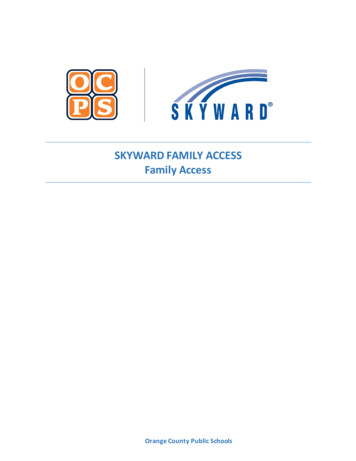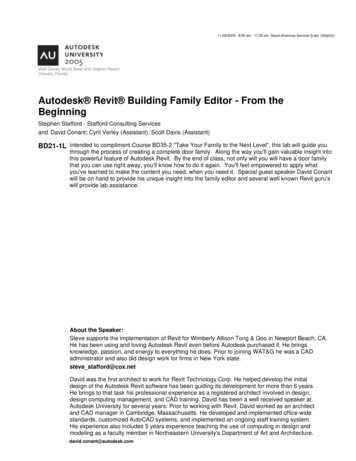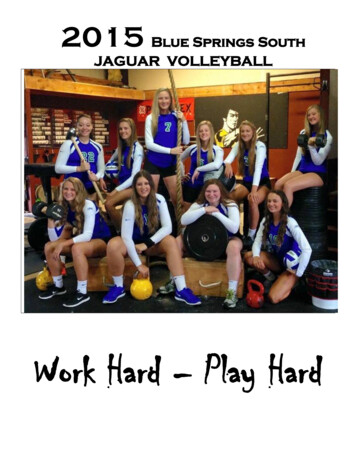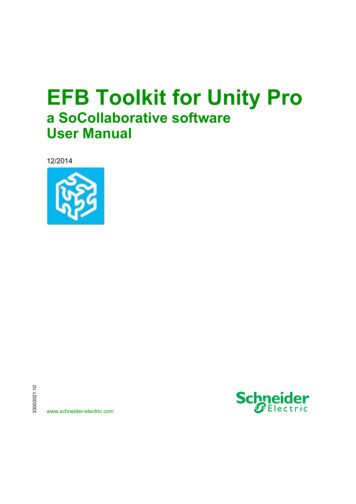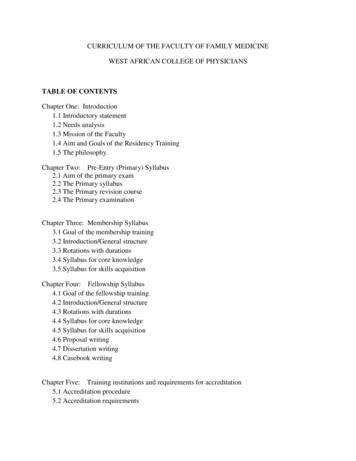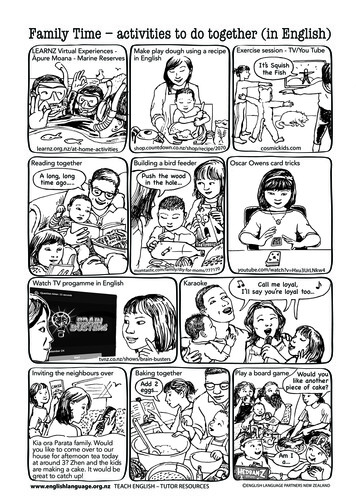
Transcription
Family Time – activities to do together (in English)LEARNZ Virtual Experiences Āpure Moana - Marine ReservesMake play dough using a recipein EnglishExercise session - TV/You Tubelearnz.org.nz/at-home smickids.comReading togetherBuilding a bird feederA long, longtime ago .Push the woodin the hole momtastic.com/family/diy-for-moms/777 1 7 0KaraokeWatch TV progamme in EnglishIt’s Squishthe FishOscar Owens card tricksyoutube.com/watch?v Hxu3UrLNkw4Call me loyal,I’ll say you’re loyal too.tvnz.co.nz/shows/brain-bustersInviting the neighbours overBaking togetherAdd 2eggs.Kia ora Parata family. Wouldyou like to come over to ourhouse for afternoon tea todayat around 3? Zhen and the kidsare making a cake. It would begreat to catch up!www.englishlanguage.org.nz TEACH ENGLISH – TUTOR RESOURCESPlay a board gameWould youlike anotherpiece of cake?Am Ia. ENGLISH LANGUAGE PARTNERS NEW ZEALAND
2Family time – ideas for using the sequence storyNote for Tutors: Activities referred to in Ideas for using the sequencestory are related to the suggested Vocabulary and text which you canfind on page 9 of this document.Warm up – before you look at the picture sequenceDiscuss what language the family speaks at home. It’s important to keepspeaking the home language to the children to maintain links to culture andfamily, and because bilingualism give cognitive advantages.Suggest that sometimes there are activities that the learner could do in Englishthat will help both the learner tap into the children’s English ability, and thechildren’s progress at school.Focus on key vocabulary (see page 9 for suggested vocabulary)Either provide the learner with a list of target vocabulary and ask her to matchthe words to what she can see in the pictures (Lower level), or brainstormwords with the learner (Higher level).Question stories (See pages 12-13 for suggested questions)Ask a series of questions relating to the pictures. The learner’s answers canguide them to describe what is happening in each picture. You could thencompare the learner’s version with the original text.Alternatively encourage the learner to ask you some questions about thepictures. Learners often get more practice answering than asking questions.Jumbled sentences – readingCut up the text on page 14 into strips. Each strip relates to one of the pictures.Jumble up the strips.Look at the pictures and ask the learner(s) to match the appropriate sentenceto the right picture.Point of view:Write a description for each picture from one person’s point of view (forexample from the little boy’s point of view).Gapped text:Gap out some words in the text on page 10-11 after reading it with yourlearner. The learner completes the text by referring to the pictures.Depending on your learner’s needs, you can focus on particular words: e.g.o content words from the target vocabulary in the picture (this helps withrevision)Ideas for using the Family time sequence story by Natalie Greenly, ESOL tutor
3Jiayi and the children are making a feeder for their garden. They areusing a recycled milk and a milk . They are following thefrom a website. Jiayi is helping Bai poke a perch for the intothe bottle. They are going to put some water in, it from a tree intheir back yard and the birds.o or “grammar” words: e.g. prepositionsJiayi and the children are making a bird feeder their garden. They areusing a recycled milk carton and a milk bottle. They are following theinstructions a website. Jiayi is helping Bai poke a perch for the birdsthe bottle. They are going to put some water , hang it a tree intheir back yard and watch the birds.o or articles and determinersJiayi and children are making bird feeder for their garden. They areusing recycled milk carton and milk bottle. They are followinginstructions from a website. Jiayi is helping Bai poke perch forbirds into bottle. They are going to put water in, hang it fromtree in back yard and watch birds.Listening practice: True/falseSay some sentences about the pictures, some true, some false:e.g. The little girl is sitting on the dad’s knee (False); The dad isreading to the little boy (True)There are three possible activities here: The learner simply says true for the true ones and falsefor the false ones. The learner repeats the true sentences and stays silent forthe false ones (So it’s a kind of drill, but the learner has to process themeaning as well as repeat) The learner says true for the true ones and corrects the false ones: e.g.No, she isn’t sitting on his knee, she is sitting on the floor.In a higher level class the learners can work in pairs. One learner can say atrue/false sentence and the other responds. Then they swap roles.Sort the picturesAfter discussing the pictures ask the learners to sort them into: things I have done with my family things I’d like to try things I would not like to tryIdeas for using the Family time sequence story by Natalie Greenly, ESOL tutor
4Extension activitiesLearnzThese are virtual “trips” that the family can do on a laptop ortablet.These consist of short videos accompanied by some questions,and suggested follow-up activities. The tutor could help thelearner prepare by watching the video and help with any trickyvocabulary, and then discuss what activities might beinteresting.Some of these trips have activities that can be done at home, for example: Backyard bioblitz – find invertebrates in the backyard What’s that bird – identify birds in the garden Matariki and Navigation – look at the night skies Ko Wai Au? Who Am I? – the child interviews a relative – there aresuggested questions. This is a very language-rich activity.Make PlaydoughGo through the recipe from Countdown and make sure thelearner understands the instructions. The only unfamiliar itemmay be Cream of Tartar – this is easily obtainable from anysupermarket.Watch the video with your learner and talk about what thechild is making with the playdough. What has the learneralready got in their kitchen that the children can use with playdough (straws,toothpicks, garlic press, masher, cookie cutters, rolling pin etc?) There are alsoitems like googly eyes, feathers etc that you can buy at the dollar shop tomake the creations more fun.There is a good list of other creative ideas with playdough hereExercise session from TV or YouTubeCosmic Kids are exercise sessions which incorporate yoga movements into astory for children. They are very language-rich. Watch the Squish the Fishvideo and talk about the movements and the language.Take it in turns to give each other instructions to do some of the movementsshown in the video sit on the floor cross your legsIdeas for using the Family time sequence story by Natalie Greenly, ESOL tutor
5 hold your arms out wide to the sidetwist your body around to the sideLift your arms up above your headbend your kneestouch your toeskneel on the floorstand uplift up one handlift up one legstand on one legcup your hands round your mouthblow or breathe outbreathe instretch your armsbend forwardswave your handsput one foot on top of the otherbring your hands togetherhold your hands over your headkick your legs outrun on the spotlie on your tummylie flat on your backpoint your toesturn your head and look behind youbring your chin up and look upstand with your feet wide apartsit on the floorhug your knees to your chestmake goggles with your finger and thumbput your hands behind your backclasp your fingers togethersit with your legs to one sidelook over your shoulderjump on the spothold your foot in your handTeach your learner to play Simon says. The family can then play to together topractice the instructions above.Ideas for using the Family time sequence story by Natalie Greenly, ESOL tutor
6Reading togetherEncourage your learner to read in English to the children.Go together to the library and show your learner where toborrow books for the children. If your learner does not feelconfident reading to their children, practice with them firstso that they feel happy about the meaning andpronunciation. Other options are for the tutor to record themselves reading the bookfirst on the learner’s phone (most phones have a voice recorder option)so the learner can practice in their own time to borrow books with an accompanying CD. For the learner to record themselves reading on Flipgrid (a free videoapp) where there is space for feedback to watch and listen to books read aloud on YouTubeBuilding a bird feederUsing materials around the house to for crafts is a great way to practice thelanguage of instructions. Instructions for a number of different simple birdfeeders can be found here.If you want to make a reading activity from this kind ofmaterial1. Show the final picture and ask your learner to predict: What it is made from – i.e. a list of supplies How it is made – i.e. instructions2. Read the list of supplies with your learner. Did they get it right? What didthey forget?3. (For this step you need to have already copied the instructions and jumbledthem up, so they are no longer in order. Remember to remove thenumbers!) Ask your learner to read the instructions and put them back inorder. Then check against the original.4. Help your learner with any vocabulary or anything they don’t understand.Ideas for using the Family time sequence story by Natalie Greenly, ESOL tutor
7Oscar Owen’s Card tricksTurn off the sound and watch each trick. What happened?Why is it surprising? Why does it look like magic?Get a pack of cards and try and follow the instructions. Canyou work out how the floating card trick (#8) is done?Watch TV programmes in EnglishBrain Busters is a great quiz-based show to watch with the family as it is verylanguage-based. It’s good for listening activities withthe learner. At time of writing it is available on TVNZon demand.An activity can be for the tutor to select a sectioninvolving a number of questions. The tutor watches inadvance and makes a note of all the answers.In class, provide your learner with the answers, eitherin order, or to make it more challenging, jumbled up. Help the learner toformulate a question for each answer. Then listen to the actual question. Howclose were they?KaraokeSongs are a great way to practice pronunciation, andthere are plenty of songs on YouTube, many with lyricsready to go.If lyrics are not available, it is sometimes possible toturn on the automatic captions. Sometimes these willnot reproduce the words exactly but this can be made into a learning momentas you examine the difference between the “dictionary” form of the word,when it is spoken by itself, and what happens to the sounds when the word isincorporated into the stream of speech. This is a very useful exercise forlearners as they struggle to understand rapid Kiwi speech.Another possibility is to search up the lyrics, copy them and gap out some ofthe words. Get your learner to guess the missing words (to make it easier youcan provide the learner with a list of possibilities) and then listen to the song tocheck.Some suggestions for fun songs to get your learner started, chosen eitherbecause they have clear pronunciation or interesting grammar features (youneed to scroll down to the middle of the page to get to the suggestions).Ideas for using the Family time sequence story by Natalie Greenly, ESOL tutor
8Inviting the neighbours overIt’s useful for learners to know how to invite people over, and howto accept and refuse an invitation appropriately. You could firstpractice writing texts for various kinds of invitations.Watch this video from Cambridge explaining ways to refuse oraccept an invitation, or to cancel an arrangement. I’d love to but I’m seeing . that day / I’ve got something onSounds good. What time? Where shall we meet?I’m really sorry but I don’t think I can make it because something’scome up.There are some good follow-up practice activities on ESL flow.Baking a cakeIf your learner is interested in cooking, you might like to look ata recipe in English. Chelsea Sugar has some good recipes – e.g.for Banana Cake with chocolate icing, which has a written-outrecipe and accompanying video. Read the recipe Clarify vocabulary Play this match-up game on Wordwall. Explain measurements (cup, tsp, tbsp. etc) Watch the video and describe what is happeningSuggest that the learner makes the recipe with their children.Playing a board gameSome word-based board games are great for languagedevelopment without any adaptation – Scrabble, Guess Who,Bananarama.Headbanz, the game in the picture, is a version of the classic 20questions game, where player ask a series of question to guesswhat is on the picture. This is a popular game for learners topractise forming those tricky Yes/No questions in English andrequire minimal preparation.Ideas for using the Family time sequence story by Natalie Greenly, ESOL tutor
9Family time – Activities to do together (in English)Suggested text and vocabularyNote for Tutors: For ideas about how to use this suggestedvocabulary and text, refer to Ideas for using the sequence storyon page 2 of this document.Target Vocabulary (see page 2 for instructions)virtual school trip – go snorkelling - stay safe - mask and snorkel - handsignal - sea creaturesmake / play with playdough - use a recipe - find something online - easyto do - flour -cream of tartar – salt - food colour - vegetable oil - stir themixture.exercise session - copying the movements - arms held out wide - twistyour body- enjoy a storygo to the library - borrow books - reading a book to someone - look at thepictures - ask questions.make a bird feeder - recycled milk carton - follow instructions – website help someone do something - perch - hang something from somethingwatch a programme - game show - tricky questions - think of the rightanswersing a song - lyrics - sing along – microphone - record a songinvite the neighbours around - write / send a text - cake recipes.bake a cake - afternoon tea - get the ingredients out – grease and line abaking tin - dry ingredients - bowl - next step - add something tosomething - mixture.come round for afternoon tea - cut a slice of cake - offer something tosomeone – chat - play a board game - guessing game - picture card headbandVocabulary and text for the Family time sequence story by Natalie Greenly, ESOL Tutor, 2020
10StoryIt’s important to keep speaking your home language to your children. Butthere are lots of activities you can do with your family in English.Virtual tripsThe children Liling and Bai are going on a virtual school trip from home.They are looking at a programme on snorkelling. It is fun, but you mustlearn to stay safe. They are pretending to go snorkelling. They arewearing masks and snorkels and practising the hand signal to show theyare OK and safe. If you go snorkelling you can see beautiful fish and otherinteresting sea creatures.Make playdough using a recipe in EnglishMum Jiayi is making playdough with the children. She is using a recipeyou can find online. It’s easy to do at home. You need flour, cream oftartar, salt, food colour and vegetable oil. Jiayi is helping Bai to stir themixture. Afterwards Liling and Bai are going to play with the playdough.Exercise session from TV or YouTubeJiayi, Liling and Bai are watching an exercise session on YouTube. Thepresenter is telling them what movements to do and the family is copyingthe movements. They are standing with their arms held out wide andtwisting their bodies to one side and the other. The family is also enjoyingthe story about “Squish the Fish”.Reading togetherThe family have been to the library and have borrowed some books forthe children. Dad Zhen is reading one of the books to Bai, and Liling isreading her own book. Bai likes looking at the pictures and askingquestions.Making a bird feederJiayi and the children are making a bird feeder for their garden. They areusing a recycled milk carton and a milk bottle. They are following theinstructions from a website. Jiayi is helping Bai poke a perch for the birdsinto the bottle. They are going to put some water in, hang it from a treein their back yard and watch the birds.Vocabulary and text for the Family time sequence story by Natalie Greenly, ESOL Tutor, 2020
11Oscar Owen’s Card tricksLiling is practising her magic card tricks. She has watched the instructionscarefully on YouTube. She has got a pack of cards and is practicing one ofthe tricks. She needs to try over and over again to get it right. Later shewill show her family.Watching a TV Programme in EnglishJiayi and Liling are watching a New Zealand programme. It is a gameshow for children with lots of tricky questions. Liling is trying to think ofthe right answer.KaraokeThe family are singing a song together in English. It is a song by a famousNew Zealand singer called Dave Dobbyn. They have learned the lyrics andare playing the music and singing along. Jiayi is holding a microphone torecord the song.Inviting the neighboursJiayi is inviting the neighbours around for afternoon tea at 3pm. She iswriting a text to send to them. Liling is holding a book with some goodcake recipes.Baking togetherZhen and the children are baking a banana cake for afternoon tea withthe Parata family. They have got all the ingredients out, and greased andlined the baking tin. They have already put the dry ingredients into thebowl. Liling is reading the next step in the recipe. Bai is holding an egg,ready to add it to the mixture.Playing a board gameThe neighbours have come round for afternoon tea. Jiayi is cutting slicesof cake to offer them. Everyone is drinking juice or tea. The adults arechatting. The children are playing a board game together. It is a guessinggame: they wear a picture card stuck in a headband on their head, andask questions to guess what is on the picture.Vocabulary and text for the Family time sequence story by Natalie Greenly, ESOL Tutor, 2020
12Questions for “Question stories” (see page 2 for instructions)Pic 1WhatWhatWhatWhatare Liling (the little girl) and Bai (the little boy) wearing?are they doing? What are they watching?are they doing with their hands?can you see at the bottom of the picture?Pic 2WhatWhatWhatWhatis Jiayi (the mum) doing? What is she holding?is Bai holding? What is he doing with it?do you use playdough for?do you make playdough from?Pic 3Who is in the picture?What are they watching? What can you see on the TV screen?What are they doing?What is Bai wearing?Pic 4Who is in the picture?Where do you think they have been? What did they get there?What is Zhen (the dad) doing? What is he holding?What is Bai doing?What is Liling doing?Pic 5Who is in the picture?What is Liling holding?What is Bai doing?What is Jiayi saying to Bai?Pic 6What has Liling got in front of her?What is the card doing?How do you think she is doing this?How do people do card tricks?Pic 7What can you see on the television?What kind of programme do you think Brain Busters is?What do you think Liling is thinking about?Pic 8Who is in the picture?What is the family doing?What is Jiayi holding? Why?Pic 9What is Jiayi holding?Vocabulary and text for the Family time sequence story by Natalie Greenly, ESOL Tutor, 2020
13What is she writing about? What is going to happen at 3pm?What is Liling holding? What is she going to make? Why?Pic 10Who is in the picture?Where are they?What are they doing?What is Liling reading?What is Bai holding?What is in the bowl?What is next to the bowl? What are they going to do with it?Pic 11Who is in the picture?What are is Jiayi doing?What are the other adults doing?What are the children doing?What is the name of the game?What have the children got on their heads?What kind of game do you think they are playing?Vocabulary and text for the Family time sequence story by Natalie Greenly, ESOL Tutor, 2020
14Descriptions for “Jumbled sentences” (see page 2 forinstructions) - Photocopy and cut up.Liling and Bai are going on a virtual school trip andpretending to snorkel.Jiayi is making playdough with the children.Jiayi, Liling and Bai are watching an exercise session onYouTube and copying the movements.Zhen is reading a book to Bai and Liling is reading a book byherself.Jiayi and the children are making a bird feeder for their gardenfrom recycled milk bottles and cartons.Liling is practising her magic card tricks.Jiayi and Liling are watching a game show on TV.The family are singing a song together in English.Jiayi is inviting the neighbours around for afternoon tea at3pm.Zhen and the children are baking a banana cakefor afternoon tea with the Parata family.The neighbours have come round for afternoon tea. Theadults are chatting and the children are playing a game.Vocabulary and text for the Family time sequence story by Natalie Greenly, ESOL Tutor, 2020
2 Family time - ideas for using the sequence story Note for Tutors: Activities referred to in Ideas for using the sequence story are related to the suggested Vocabulary and text which you can find on page 9 of this document. Warm up - before you look at the picture sequence
